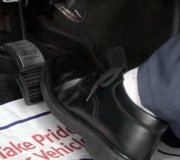Thanks for visiting 2CarPros.
I would consider this a problem. After that many pumps the brake pedal should become hard and have only an inch or so of travel until it gets stops. What you are experiencing is usually a sign of an internal leak in the master cylinder. Fluid bypasses the O rings on the piston resulting in this. I'll post replacement info below.
These videos and guides can help us fix it.
https://youtu.be/w7gUsj2us0U
and
https://youtu.be/WDxvEQrMkBg
and
https://www.2carpros.com/articles/brake-pedal-goes-to-the-floor
Please run down these guides and report back.
Brake Master Cylinder Replacement
NOTICE
Do not spill brake fluid on the vehicle; it may damage the paint. If brake fluid gets on the paint, wash it off immediately with water.
NOTE:
- Press the brake pedal several times to deplete the vacuum in the brake booster.
- Be careful when handling the master cylinder. Do not hold it at the piston, or the piston may separate from the body. If the piston separates from the body, then the master cylinder must be replaced. Do not reinsert the piston back into the master cylinder body.
- Be careful not to damage or bend the brake lines during removal and installation.
- After removal, plug the ends of the hoses and the joints to prevent spilling brake fluid.
1. Remove the reservoir cap, then remove the brake fluid from the master cylinder reservoir with a syringe.
2. Disconnect the brake fluid level switch connector (A).
3. Disconnect the brake lines (B) from the master cylinder (C). To prevent spills, cover the hose joints with clean rags or shop towels.
4. Remove the master cylinder mounting nuts (D).
5. Remove the master cylinder from the brake booster (E). Be careful not to bend or damage the brake lines when removing the master cylinder.
6. Remove the O-ring (F) from the master cylinder.
NOTE: Replace the O-ring whenever the master cylinder is removed.
7. Install the master cylinder with a new O-ring in the reverse order of removal, and note these items:
- Check the brake booster pushrod clearance See: Vacuum Brake Booster > Adjustments > Brake Booster Pushrod Clearance Adjustment.
- Coat the new O-ring with silicone grease (Shin-EtsuG40M).
- Make sure not to get any silicone grease on the terminal part of the connectors and switches, especially if you have silicone grease on your hands or gloves.
- Check the brake pedal height and free play after installing the master cylinder, and adjust it if necessary See: Brake Pedal Assy > Adjustments > Brake Pedal And Brake Pedal Position Switch Adjustment.
8. Bleed the brake system See: Brake Bleeding > Procedures > Conventional Brake System Bleeding.
9. Spin the wheels to check for brake drag.
Image (Click to make bigger)
Friday, February 8th, 2019 AT 9:11 PM















